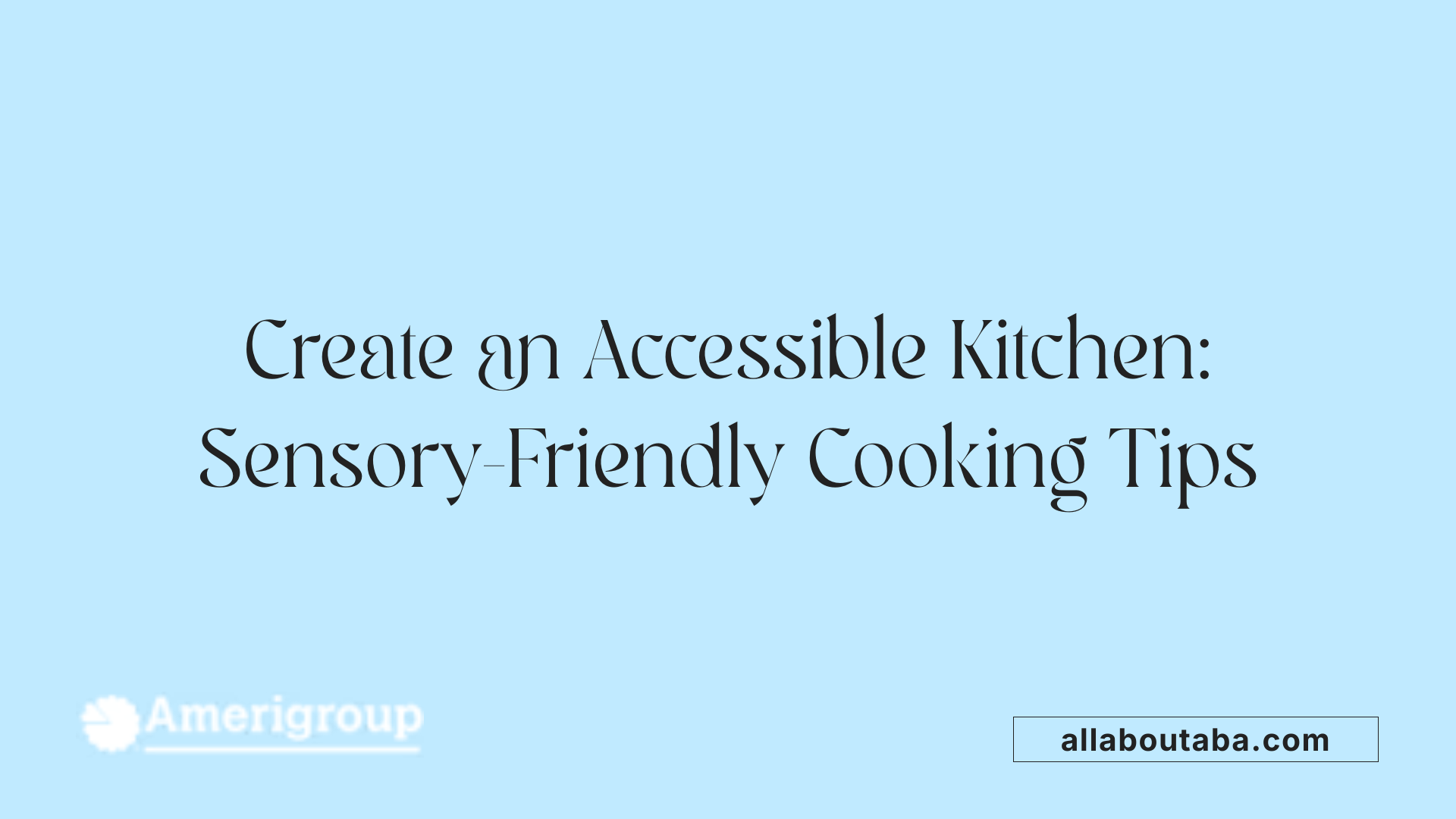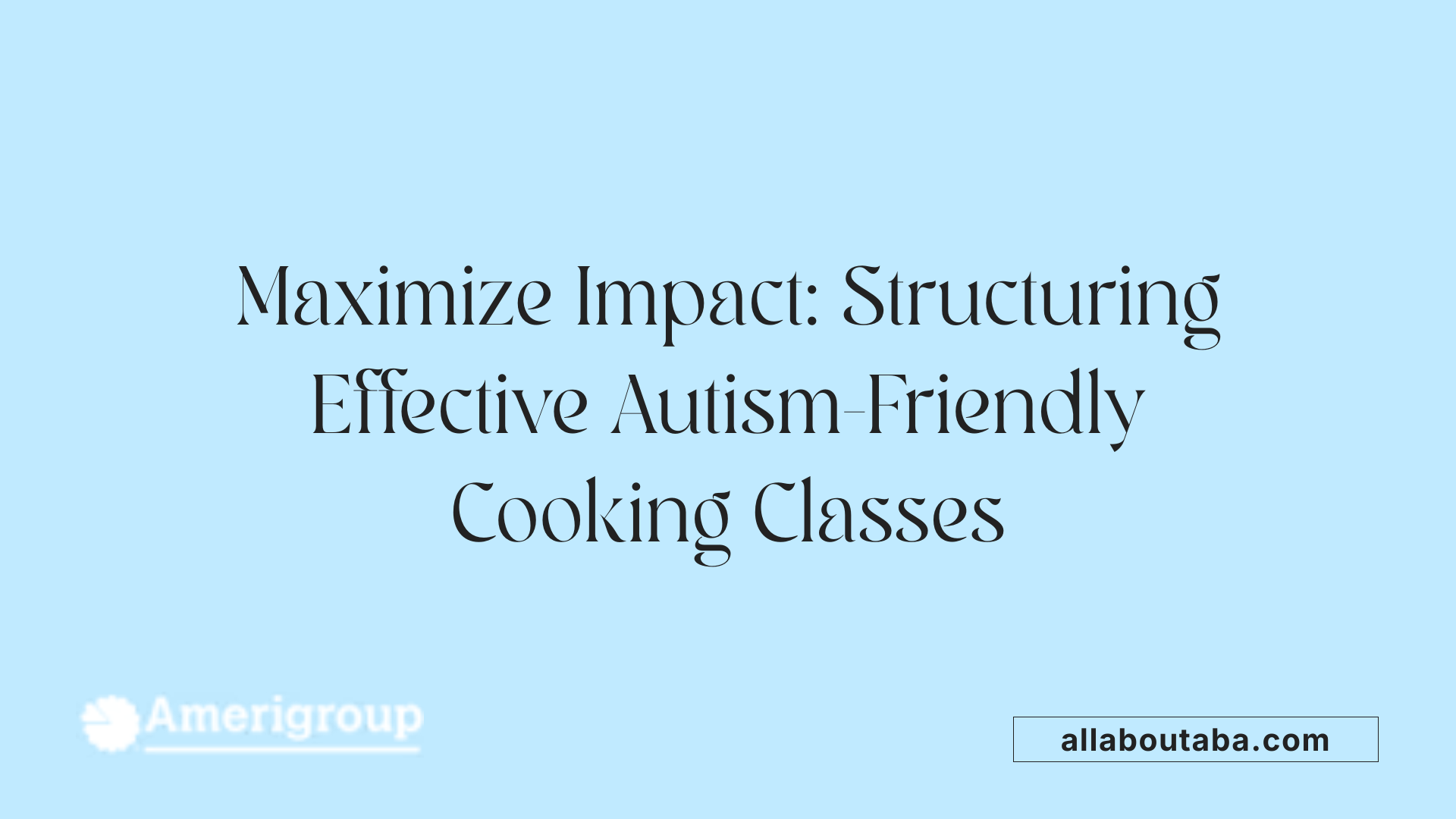Best Practices For Autism-Friendly Cooking Classes
Creating Inclusive and Effective Cooking Classes for Children with Autism
Cooking is an invaluable activity that promotes independence, sensory integration, social skills, and cognitive development in children with autism. Designing autism-friendly cooking classes requires thoughtful strategies to address sensory sensitivities, motor challenges, and cognitive needs, while fostering a positive learning environment that encourages skill-building and confidence. This article explores best practices, resources, and innovative approaches which can make culinary education accessible, engaging, and safe for neurodivergent learners.
Integrating Sensory-Friendly Strategies and Adaptations

How can cooking activities be adapted to meet the sensory, motor, and cognitive needs of children with autism?
Creating successful cooking experiences for children with autism requires thoughtful modifications to accommodate their unique sensory, motor, and cognitive profiles. These adaptations help ensure that cooking is both accessible and enjoyable, fostering independence and skill development.
One fundamental strategy involves simplifying tasks by breaking down recipes into clear, manageable steps. Visual supports such as picture-based instructions, visual schedules, or PECS cards can be used to illustrate each stage of the cooking process. This approach helps children understand what to do next, reducing anxiety and increasing confidence.
Addressing sensory sensitivities is crucial. Many children with autism may have aversions to certain textures, smells, or visual stimuli. To manage these reactions, chefs and caregivers can select sensory-friendly ingredients—soft, easy-to-chew foods, mild aromas, and visually appealing presentations that are not overwhelming. Incorporating sensory activities like touching different textures through play (e.g., slime or play-dough) can help desensitize children gradually.
Using specialized tools and protective gear can significantly improve the cooking experience. Items like gloves, goggles, and textured towels offer sensory input while providing safety and comfort. For instance, onion goggles can protect the eyes during strong-smelling chopping tasks, and adapted utensils such as larger or ergonomic grips can ease motor challenges.
Supporting motor skills development involves demonstrations, hand-over-hand assistance, and encouraging the use of appropriate utensils. Starting with simple activities—such as stirring, pouring, or tearing ingredients—can help children build fine and gross motor coordination.
Creating structured routines with visual prompts fosters predictability, which helps reduce stress. Safety considerations are equally important; visual cues and supervision ensure children handle hot surfaces, sharp knives, and other hazards confidently.
Incorporating sensory regulation techniques, such as providing calming textures or using sensory-friendly lighting and sounds in the kitchen, promotes a relaxed environment. These adjustments allow children to explore food textures, smells, and visuals at their own pace.
Overall, adapting cooking activities to meet each child's sensory, motor, and cognitive needs involves combining visual supports, sensory accommodations, specialized tools, and structured routines. This personalized approach not only enhances skill development and independence but also makes cooking a positive, confidence-building experience.
Utilizing Visual Supports and Structured Routines

What specific approaches and tools can be used to include visual aids and structured routines in autism-friendly cooking education?
Incorporating visual supports into cooking education for children with autism can significantly enhance understanding and independence. One effective method is the use of visual recipes, which include pictures or sketches of each ingredient, utensil, and step involved in the cooking process. These visual aids make instructions more concrete and accessible, especially for children who benefit from visual learning.
Structured routines are also vital. Visual schedules and step-by-step guides can help children follow the sequence of activities independently. For example, a visual step chart showing stages like washing, chopping, mixing, and cooking helps reduce uncertainty and anxiety, encouraging children to participate actively.
A powerful approach is task analysis, which involves breaking down complex cooking skills into smaller, manageable steps. Visual prompts or cues can be attached to each step, providing clear cues for what comes next. This supports children in mastering each part of the process before moving on to more advanced tasks.
Assistive technologies expand these strategies further. Cooking apps designed with visual prompts or videos demonstrating each step allow children to revisit instructions as needed. Video demonstrations can be especially useful, presenting a visual and auditory example of the task, helping to reinforce learning.
Using audio prompts, such as recorded instructions or cues played at each step, caters to children with different learning preferences. These tools, when combined with regular monitoring and individual tailoring, foster an environment where children feel supported and confident.
Overall, integrating visual aids and routines in cooking programs creates a structured, supportive, and engaging experience. It addresses diverse needs, promotes independence, and encourages children with autism to develop essential life skills while enjoying the process.
Fostering Skills and Confidence through Structured Activities

How can step-by-step instructions, visual supports, and gradual skill development enhance cooking activities for children with autism?
Teaching cooking to children with autism involves breaking down complex tasks into manageable steps. Visual supports, such as picture-based guides, video prompts, or step-by-step charts, make instructions clearer and easier to follow. These tools help children understand what to do next, reducing frustration and improving focus.
Gradual skill development is essential. Starting with simple activities like stirring or pouring, then progressing to chopping or measuring, helps children build confidence and fine motor skills. Repeating tasks and providing positive reinforcement encourage mastery and independence.
This structured approach promotes sensory engagement and cognitive growth. When children see and do each step, they develop planning and problem-solving abilities. Over time, they become more comfortable, capable, and eager to take on new cooking challenges.
How can cooking support the development of independence and social skills?
Cooking offers a rich platform for fostering independence. When children learn to prepare meals, they gain practical life skills that translate to self-sufficiency. Ensuring safety, hygiene, and proper food handling become part of their routine, building confidence in managing daily tasks.
Social interaction is naturally integrated into cooking activities. Working with a partner or family members encourages communication, patience, and teamwork. Sharing meals and discussing flavors can develop self-esteem and social bonds.
Participating in communal cooking classes, like those at Shrub Oak International School or programs led by expert chefs, also enhances social skills. These settings provide relaxed environments where children practice patience, listen to instructions, and celebrate their achievements.
What methods can help increase confidence, skills, and independence in autistic individuals through cooking activities?
To boost confidence and independence, it’s effective to incorporate visual instructions and support tailored to individual sensory needs. Using visual aids helps children understand each step clearly, reducing anxiety and promoting active participation.
Sensory-rich activities, such as exploring different textures, smells, and temperatures, can be customized to accommodate sensitivities. For example, using gloves or specialized utensils, or starting with softened foods, makes cooking more accessible.
Beginning with simple recipes that are quick and easy to prepare allows children to experience success early on. As skills develop, more challenging tasks can be introduced gradually, fostering a sense of achievement.
Facilitating social interactions through partner work or involving family promotes communication and patience. Creating consistent routines around cooking and safety fosters a secure environment where children can grow more autonomous.
Supervision and adapted tools are vital to ensure safety while allowing children to take ownership of their cooking tasks. Including children in decision-making about recipes can also increase their motivation and confidence.
How do these approaches contribute to lasting behavioral and developmental improvements?
Implementing structured, supportive cooking activities has been shown to improve not only culinary skills but also broader developmental areas such as communication, problem-solving, and emotional regulation. Mastering cooking tasks encourages independence, which can lead to greater self-esteem and community involvement.
By practicing meal preparation and sharing, children develop routines, patience, and social confidence. These experiences foster resilience, adaptability, and a positive attitude toward trying new foods and activities.
In essence, combining step-by-step guidance, sensory adaptation, and social opportunities creates a comprehensive approach that supports long-term growth. Tailoring activities to individual needs ensures that each child can enjoy the fun of cooking while acquiring essential life skills that promote independence and confidence.
Designing Effective and Accessible Food Programs
How can cooking programs be designed to be effective, accessible, and engaging for children with autism?
Creating cooking programs that truly benefit children with autism involves careful planning to address their unique sensory, motor, and social needs. One of the most effective approaches is incorporating sensory supports. Since many children with autism experience sensitivities to textures and smells, programs should tailor recipes and activities to individual preferences and tolerances. Using sensory aids such as gloves, goggles, textured towels, and specialized utensils can help children participate more comfortably and confidently.
Structured routines greatly reduce anxiety. Visual supports like daily schedules, visual timers, and step-by-step guides help children anticipate what’s next, maintaining focus and reducing stress. These tools make the cooking process predictable, which is especially helpful for children who thrive on routine.
Adaptive equipment and support strategies are essential to promote independence. For children with fine motor challenges, using larger or specially designed utensils can make tasks easier. Breaking down recipes into small, manageable steps guides children through each stage, fostering a sense of achievement and boosting confidence.
Social interaction plays a vital role. Collaborative cooking activities encourage teamwork and communication. Friendly peer support or guided assistance helps children develop social skills and a sense of community. Sharing the finished meal offers an opportunity for social engagement beyond the kitchen.
In addition, cooking can serve as a calming activity that helps regulate emotions. The repetitive motions of stirring or kneading are soothing for many children with autism. Creating a calm, positive environment free of unnecessary distractions allows children to enjoy the sensory experience.
Integrating visual learning tools such as picture-based recipes, video prompts, and visual prompts helps children comprehend instructions and encourages independent execution of tasks. These tools also make learning more engaging and accessible.
Finally, programs should be flexible and personalized. Recognizing each child's preferences, sensitivities, and developmental level ensures that the activity remains enjoyable and beneficial. Employing patience and encouragement fosters a positive attitude toward cooking, which can translate into greater independence in everyday life.
In sum, designing effective cooking programs for children with autism involves balancing sensory considerations, visual supports, and social opportunities within a structured environment. This combination enhances engagement, learning, and enjoyment, setting the stage for developing essential life skills and fostering a lifelong love of food and cooking.
Structuring and Improving Cooking Classes for Maximum Impact

How can I structure and improve autism-friendly cooking classes to maximize benefits for participants?
Enhancing the effectiveness of cooking classes tailored for children and young adults with autism involves a thoughtful balance of structure, sensory support, social engagement, and encouragement of creativity.
One fundamental approach is establishing clear routines. Consistent class formats utilizing visual supports—such as step-by-step pictures, checklists, or video prompts—help participants understand expectations and follow instructions more easily. For example, resources like the 'Coach in the Kitchen' cookbook include visual guides that simplify complex tasks.
Sensory considerations are crucial given the sensory sensitivities common among autistic individuals. Adapting the environment with tools like gloves, goggles, textured towels, and specialized utensils can reduce sensory overload. Selecting recipes with familiar textures and flavors, and gradually introducing new sensations, encourages comfort and exploration.
Using adaptive kitchen tools, such as child-friendly knives, larger cookie cutters, or utensils with easy grips, supports motor skill development and safety. Breaking tasks down using task analysis makes activities less overwhelming and boosts confidence. For instance, dividing a recipe into manageable steps allows children to focus on one part at a time.
Incorporating safety and hygiene education, including handling sharp objects and hot surfaces, promotes independence and self-care. Visual cues and simplified instructions help reinforce these important skills.
Social interaction and group participation are also vital. Structuring activities where children have specific roles—such as measuring ingredients, setting the table, or cleaning—can foster teamwork, patience, and communication. These interactions often take place in a relaxed, shared mealtime setting, naturally supporting social skills. Facilitating conversations about food, flavors, and preferences can further encourage self-expression and confidence.
Creativity and sensory engagement should remain central to the program. Offering opportunities for experimentation with ingredients, presentation, and flavors allows children to express themselves and develop problem-solving skills. Incorporating quiet, calming activities—such as organizing ingredients or creative plating—can help reduce anxiety and promote emotional regulation.
Regular assessment of each participant’s sensory preferences and development helps tailor activities to individual needs. This personalized approach ensures the environment remains supportive and engaging, encouraging ongoing participation.
Finally, fostering a positive attitude towards cooking—emphasizing fun, achievement, and exploration rather than perfection—helps children develop a love for culinary activities. This mindset supports learning, independence, and lifelong skills.
By integrating these strategies—structured routines, sensory adaptations, social roles, and creativity—educators and caregivers can significantly improve the impact of autism-friendly cooking classes, enriching the lives of participants through skill development, confidence, and community connection.
Empowering Through Culinary Education
Creating autism-friendly cooking classes requires a holistic approach that incorporates sensory adaptations, visual supports, structured routines, and a focus on safety and social engagement. Utilizing evidence-based practices and innovative tools not only enhances learning outcomes but also fosters confidence, independence, and a sense of community among participants. As more programs adopt these best practices, children with autism will have greater opportunities to enjoy cooking, develop essential life skills, and participate fully in their communities.
References
- What's Cooking? Life Skills for Kids with Autism!
- Cooking Classes: Building Skills and Confidence for Autistic Students
- Spectrum Cooking Program - Autism CRC
- Accessible Chef – Accessible Cooking for Budding Chefs
- Autism Cooking School
- Cooking skills for children with autism and sensory issues
- Cooking with kids on and off the autism spectrum - WHYY
- [PDF] Cooking Classes Tailored for College Students with Autism (Practice ...
Other articles
Recent articles

Best Practices For Autism-Friendly Fitness And Recreation Centers

Best Ways To Promote Healthy Social Media Use For Autistic Teens

How To Help Autistic Children Cope With Public Speaking

Autism And Strategies For Managing Unexpected Changes

Best Podcasts About Autism For Parents And Educators

Autism And The Impact Of Seasonal Changes On Behavior

The Role Of Diet In Managing Co-Occurring Conditions With Autism

Sleep Challenges In Autism And Practical Solutions

Best Ways To Build Daily Routines For Autistic Children

Best Practices For Supporting Autistic Entrepreneurs

Autism And Strategies For Navigating Large Social Gatherings

Adaptive Sports And Recreational Activities For People With Autism

Autism And The Benefits Of Story-Based Learning Activities

Understanding The Role Of Play In Autism Development

Autism And The Impact Of Environmental Noise On Learning

How To Create Autism-Friendly Community Spaces

Autism And Chronic Health Conditions: What To Know

The Role Of Care Managers In Autism Life Planning

How To Teach Social Boundaries To Autistic Children

How Autistic Individuals Experience Empathy Differently

How To Support Autistic Employees In Remote Work Settings

Autism And The Relationship Between Motor Skills And Learning

How To Create Community Resource Guides For Autism Families

How To Teach Daily Living Skills To Autistic Teens

Autism And The Impact Of Mind-Body Practices On Stress Reduction

Autism And The Benefits Of Outdoor Group Activities

How To Create Autism-Friendly Sensory Paths In Schools

Best Practices For Autism-Friendly Park And Recreation Areas

Autism And Strategies For Reducing School Refusal

Supporting Autistic Individuals In Public Speaking

The Role Of Diet In Managing Autism Symptoms

The Benefits Of Gardening Clubs For Autism Social Development

How To Prepare Autistic Children For Dental Visits

Autism And Employment: Career Paths That Work

Best Practices For Autism-Friendly Hotels And Lodging

The Impact Of Screen Time On Autism Development

Autism Screening Tools For Early Childhood

The Role Of Physical Exercise In Autism Therapy

Best Strategies For Supporting Autistic College Students

The Role Of Technology In Autism Early Detection

Sensory-Friendly Classroom Design Ideas For Autistic Students

The Role Of Speech Therapy In Building Social Communication Skills

Best Strategies For Handling Autistic Burnout In Adults

Autism And The Importance Of Predictability In Routine

Autism And Peer Education: Teaching Acceptance In Schools

Best Practices For Sensory-Friendly Libraries And Reading Rooms

Self-Advocacy Skills For Autistic Adults

The Role Of Technology In Autism Peer Communication

Promoting Physical Activity In Children With Autism

How To Prepare Autistic Children For Medical Procedures

The Role Of Social Media In Autism Advocacy And Awareness

The Impact Of Sensory Rooms In Public Facilities For Autism

How To Create An Autism-Friendly Holiday Celebration

Best Practices For Inclusive Education For Autistic Students

Autism And Mental Health: Recognizing Signs Of Distress

Best Practices For Sensory-Friendly Waiting Rooms

The Role Of Teachers In Early Autism Red Flag Identification

Autism-Friendly Housing Design Features

Autism-Friendly Housing Design Features

How Environmental Modifications Improve Autism Outcomes

Autism And Technology-Based Learning Tools

Supporting Autistic Children Through Changes In Routine

The Link Between Autism And Working Memory Challenges

Best Practices For Autism-Friendly Cooking Classes

Autism And The Benefits Of Structured Music Lessons

Best Books To Teach Kids About Autism Acceptance

Sensory Diets And Their Benefits For Autism Management

How To Prepare Autistic Teens For Driver’s Education

How To Teach Autistic Teens About Healthy Relationships

The Role Of Visual Prompts In Building Daily Habits For Autism

Addressing Sleep Regression In Children With Autism

Understanding Social Stories And How They Help Autistic Children

Navigating Insurance Coverage For Autism Therapy Services

How To Prepare Autistic Adults For Independent Travel

Supporting Autistic Individuals In Volunteer Work

How Mindfulness Practices Can Support Autism Well-Being

Understanding Hyperfocus And Special Interests In Autism

Understanding Stimming As A Self-Regulation Tool

Sensory-Based Interventions For Autism At Home

Best Ways To Introduce Self-Advocacy In Autistic Teens

Best Ways To Support Autistic Employees In Customer Service Roles

Best Practices For Autism-Friendly Volunteer Programs

Autism And The Benefits Of Sensory Play For Emotional Growth

Autism And Strategies For Building Peer Relationships

Understanding How Autism Affects Memory Processing

Autism And Strategies For Building Coping Skills In Teens

The Role Of Parent Training In Autism Intervention Programs

Autism-Friendly Workplace Accommodations

Using Visual Timers For Autism Time Management

What Is ABA Therapy?

Autism and Sleep

Do Plastic Toys Cause Autism?

Autism Facial Expressions

Autism and Motor Skills

Which Parent Carries The Autism Gene?

Autism Symbols & Colors

Rett Syndrome: Symptoms, Causes, and Treatment

Self-Diagnosed Autism

Autism and Sound Sensitivity

Autism With Speech Delay
We’re All About You, Your Family, and Your Child

